The Role of Microstructure in Alkali–Silica Reaction Tests
Abstract
:1. Introduction
2. Materials and Methods
2.1. Materials
2.1.1. Binder
2.1.2. Additives
2.1.3. Aggregates
2.2. Mortar Preparation
2.3. Tests and Methods
- i.
- Procedure 1: At 80 °C to speed up the reaction between the alkalis and aggregates in a moisture-saturated environment (R.H. 100%) for mortars containing a high concentration of Na+ ions.
- ii.
- Procedure 2: Again at 80 °C in a 1 N NaOH solution. In this case, both mortars mixed with (2A case) or without (2B case) NaOH were studied. For mortars mixed without Na+ ions, two different curing periods of 7 and 90 days were carried out before testing at 80 °C, in order to provide the mortars with different microstructures (hereafter defined as 2B 7dd and 2B 90dd). In order to perform the test, mortars were conditioned in water at 80 °C, and the length of the specimens after this conditioning was used as the reference. Subsequently, the samples were immersed in a 1N solution of NaOH, taken out of the solution, and rapidly measured at scheduled curing times as described in ASTM C1260.
- iii.
- Procedure 3: Samples mixed with NaOH, after being cured at 25 °C and R.H. 100% for 7 days, were submitted to tests carried out at 38 °C and R.H. 100%, according to ASTM C227 (or 1293).
3. Results and Discussion
4. Conclusions
- Under all the different conditions in which accelerated tests were performed in this study, porosity largely influenced the extent of the recorded expansion.
- The influence of porosity on the macroscopic expansion was not negligible, considering the strict limit that marks the difference between inert and potentially dangerous aggregates. According to the conditions and the curing times, the differences in the recorded expansion can span from about 100 to 300%, going from the highest to the lowest w/c ratio.
- Increasing w/c ratios in cementitious materials led to higher levels of expansions under the same conditions, which were to some extent correlated with the mechanical properties of the materials. However, a more reliable correlation seems to exist between microstructure tortuosity (or connectivity), evaluated by means of the inflection point in the MIP results, and expansion, a feature that deserves further investigation.
- Since microstructural parameters (porosity and porosity’s size distribution) exert such a remarkable effect on the degree of expansion, porosity (or connectivity) of the cementitious matrix should be included in the factors (temperature, humidity, alkalis concentration, and time) that influence expansion induced by ASR.
Author Contributions
Funding
Institutional Review Board Statement
Informed Consent Statement
Data Availability Statement
Conflicts of Interest
References
- Chatterji, S. Chemistry of alkali–silica reaction and testing of aggregates. Cem. Concr. Comp. 2005, 27, 788–795. [Google Scholar] [CrossRef]
- Fanijo, E.O.; Kolawole, J.T.; Almakrab, A. Alkali silica reaction in concrete structures: Mechanisms, effects and evaluation test methods adopted in the United States. Case Stud. Constr. Mater. 2021, 15, e00563. [Google Scholar] [CrossRef]
- Mo, X.; Fournier, B. Investigation of structural properties associated with alkali–silica reaction by means of macro- and micro-structural analysis. Mater. Charact. 2007, 58, 179–189. [Google Scholar] [CrossRef]
- Multon, S.; Sellier, A.; Cyr, M. Chemo-mechanical modelling for prediction of alkali silica reaction expansion. Cem. Concr. Res. 2009, 39, 490–500. [Google Scholar] [CrossRef] [Green Version]
- Figueira, R.B.; Sousa, R.; Coelho, L.; Azhena, M.; de Almeida, J.M.; Jorge, P.A.S.; Silva, C.J.R. Alkali-silica reaction in concrete: Mechanisms, mitigation and test methods. Constr. Build. Mat. 2019, 222, 903–931. [Google Scholar] [CrossRef]
- Kawamura, M.; Fuva, H. Effects of lithium salts on ASR gel composition and expansion of mortars. Cem. Concr. Res. 2003, 33, 913–919. [Google Scholar] [CrossRef]
- Mitchell, L.D.; Beaudoin, J.J.; Grattan-Bellew, P. The effects of lithium hydroxide solution on alkali silica reaction gels created with opal. Cem. Concr. Res. 2004, 34, 641–649. [Google Scholar] [CrossRef] [Green Version]
- Feng, X.; Thomas, M.D.A.; Bremner, T.W.; Folliard, K.J. New observations on the mechanism of lithium nitrate against alkali silica reaction (ASR). Cem. Concr. Res. 2010, 40, 94–101. [Google Scholar] [CrossRef]
- Collins, C.L.; Ideker, J.H.; Willis, G.S.; Kurtis, K.E. Examination of the effects of LiOH, LiCl, and LiNO3 on alkali-silica reaction. Cem. Concr. Res. 2004, 34, 1403–1415. [Google Scholar] [CrossRef]
- Moser, R.D.; Jayapalan, A.R.; Garas, V.Y.; Kurtis, K.E. Assessment of binary and ternary blends of metakaolin and Class C fly ash for alkali-silica reaction mitigation in concrete. Cem. Concr. Res. 2010, 40, 1664–1672. [Google Scholar] [CrossRef]
- Cyr, M.; Rivard, P.; Labeque, F. Reduction of ASR-expansion using powders ground from various sources of reactive aggregates. Cem. Concr. Comp. 2009, 31, 438–446. [Google Scholar] [CrossRef]
- Aquino, W.; Lange, D.A.; Olek, J. The influence of metakaolin and silica fume on the chemistry of alkali-silica reaction products. Cem. Concr. Comp. 2001, 23, 485–943. [Google Scholar] [CrossRef]
- Thomas, M. The effect of supplementary cementing materials on alkali-silica reaction: A review. Cem. Concr. Res. 2011, 41, 1224–1231. [Google Scholar] [CrossRef]
- Saha, A.K.; Khan, M.N.N.; Sarker, P.K.; Shaikh, F.A.; Pramanik, A. The ASR mechanism of reactive aggregates in concrete and its mitigation by fly ash: A critical review. Constr Build. Mat. 2018, 171, 743–758. [Google Scholar] [CrossRef]
- Saccani, A.; Sandrolini, F.; Andreola, F.; Corradi, A.; Lancellotti, I. Influence of the pozzolanic fraction obtained from vitrified bottom-ashes from MSWI on the properties of cementitious composites. Mater. Struct. 2005, 38, 367–371. [Google Scholar] [CrossRef]
- Menéndez, E.; Sanjuán, M.Á.; García-Roves, R.; Argiz, C.; Recino, H. Sustainable and durable performance of pozzolanic additions to prevent alkali-silica reaction (ASR) promoted by aggregates with different reaction rates. Appl. Sci 2020, 10, 9042. [Google Scholar] [CrossRef]
- Jensen, A.D.; Chatterji, S.; Christensen, P.; Thaulow, N. Studies of alkali-silica reaction-part II effect of air-entrainment on expansion. Cem. Concr Res. 1984, 14, 311–314. [Google Scholar] [CrossRef]
- Gillot, J.E.; Wang, H. Improved control of alkali-silica reaction by combined use of admixtures. Cem. Concr. Res. 1993, 23, 973–980. [Google Scholar] [CrossRef]
- Collins, R.J.; Bareham, P.D. Alkali-silica reaction: Suppression of expansion using porous aggregate. Cem. Concr. Res. 1987, 17, 89–96. [Google Scholar] [CrossRef]
- Saccani, A.; Motori, A. The effect of polymer addition on alkali silica reactions in cementitious mortars. Mater. Struct. 2001, 34, 373–377. [Google Scholar] [CrossRef]
- Feiteira, J.; Ribeiro, M.S. Polymer action on alkali–silica reaction in cement mortar. Cem. Concr. Res. 2013, 44, 97–105. [Google Scholar] [CrossRef] [Green Version]
- Lingard, J.; Andic-Cakir, O.; Fernandez, I.; Ronning, T.F.; Thomas, M.D.A. Alkali-silica reactions (ASR): Literature review on parameters influencing laboratory performance testing. Cem. Concr. Res. 2012, 42, 223–243. [Google Scholar] [CrossRef] [Green Version]
- Yi, C.K.; Ostertag, C.P. Mechanical approach in mitigating alkali silica reaction. Cem. Concr. Res. 2005, 35, 67–75. [Google Scholar] [CrossRef]
- Smaoui, N.; Bérubé, M.A.; Fournier, B.; Bissonnette, B.; Durand, B. Effects of alkali addition on the mechanical properties and durability of concrete. Cem. Concr. Res. 2005, 35, 203–212. [Google Scholar] [CrossRef]
- Diamond, S. MIP: An inappropriate method for the measurements of pore size distribution in cement based materials. Cem. Concr. Res. 2000, 30, 1517–1525. [Google Scholar] [CrossRef]
- Vocka, R.; Gallè, C.; Dubois, M.; Lovera, P. Mercury intrusion porosimetry and hierarchical structure of cement pastes: Theory and experiment. Cem. Concr. Res. 2000, 30, 521–527. [Google Scholar] [CrossRef]
- Gholizadeh-Vayghan, A.; Rajabipour, F. Quantifying the swelling properties of alkali-silica reaction (ASR) gels as a function of their composition. J. Am. Ceram. Soc. 2017, 100, 3801–3818. [Google Scholar] [CrossRef]
- Duchesne, J.; Berube, M.A. The effectiveness of supplementary cementing materials in suppressing expansion due to ASR: Another look at the reaction mechanisms part 1: Concrete expansion and portlandite depletion. Cem. Concr. Res. 1994, 24, 221–230. [Google Scholar] [CrossRef]
- Monteiro, P.J.M.; Wang, K.; Sposito, G.; Dos Santos, M.C.; De Andrade, W.P. Influence of mineral admixtures on the alkali-aggregate reaction. Cem. Concr. Res. 1997, 27, 1899–1909. [Google Scholar] [CrossRef]
- Hou, X.; Struble, L.J.; Kirkpatrick, R.J. Formation of ASR gel and the roles of C-S-H and portlandite. Cem. Concr. Res. 2004, 34, 1683–1696. [Google Scholar] [CrossRef]
- Shomglin, K.; Turanli, L.; Wenk, H.R.; Monteiro, P.J.M.; Sposito, G. The effects of potassium and rubidium hydroxide on the alkali-silica reaction. Cem. Concr. Res. 2003, 33, 1825–1830. [Google Scholar] [CrossRef]
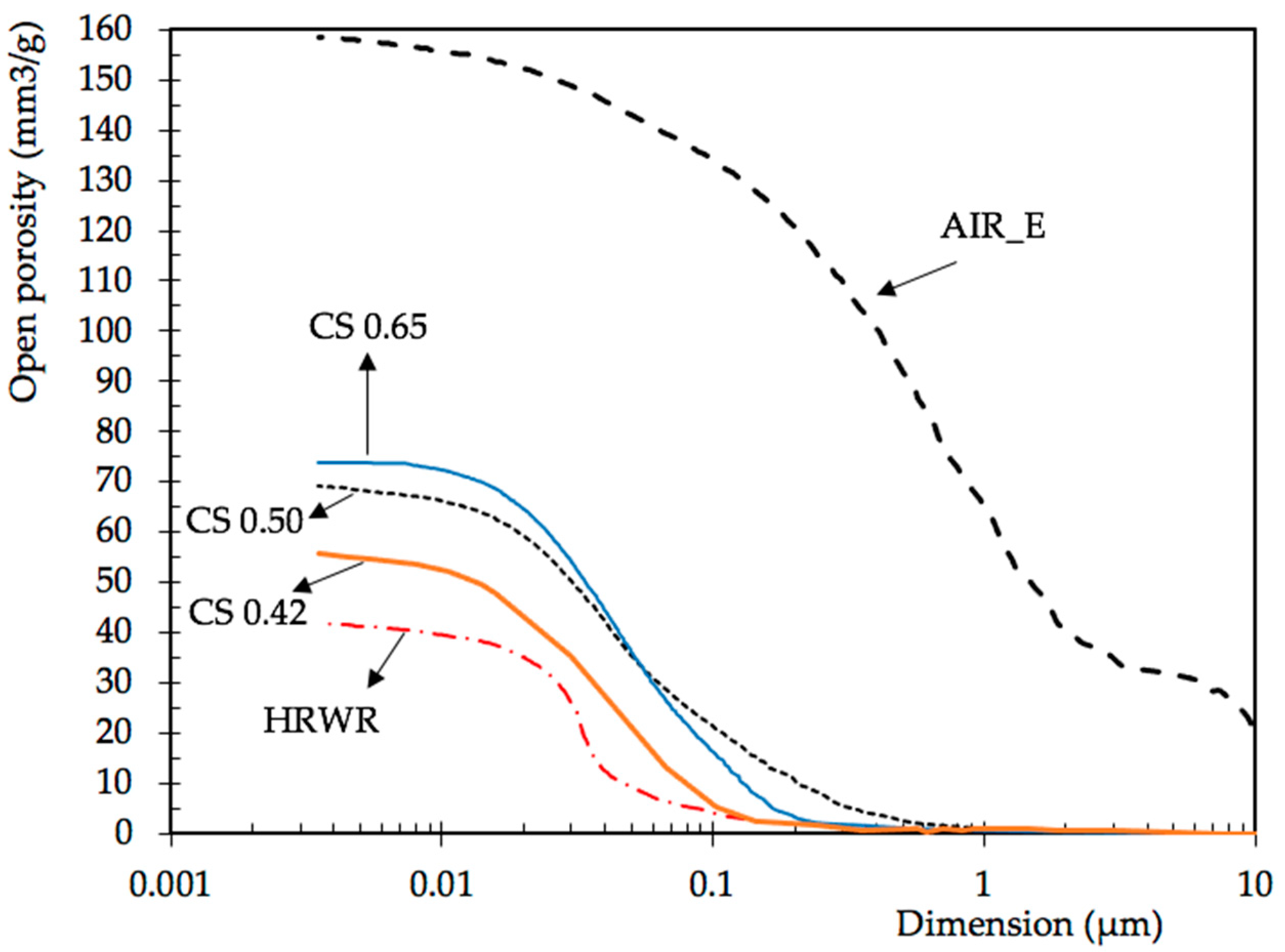
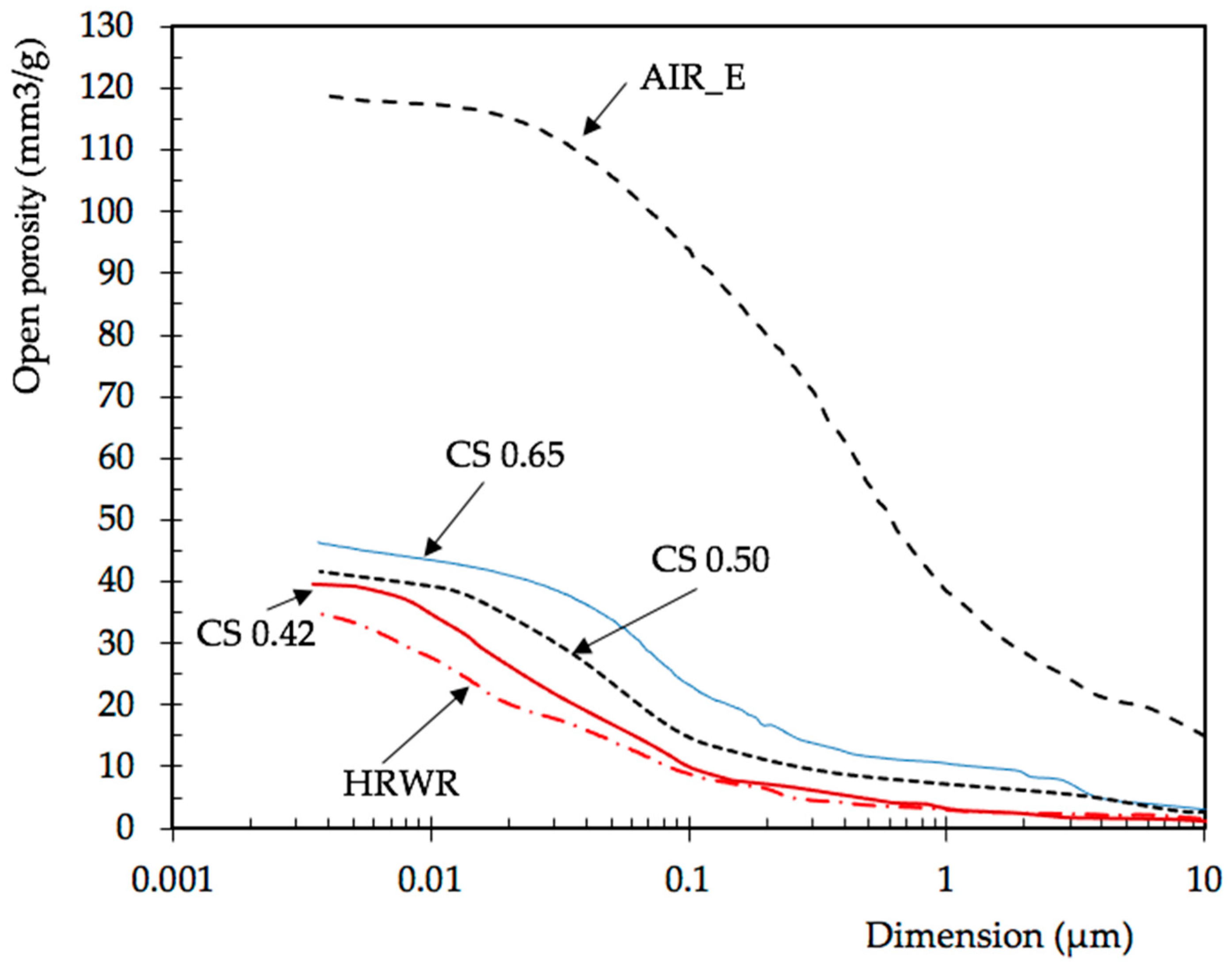
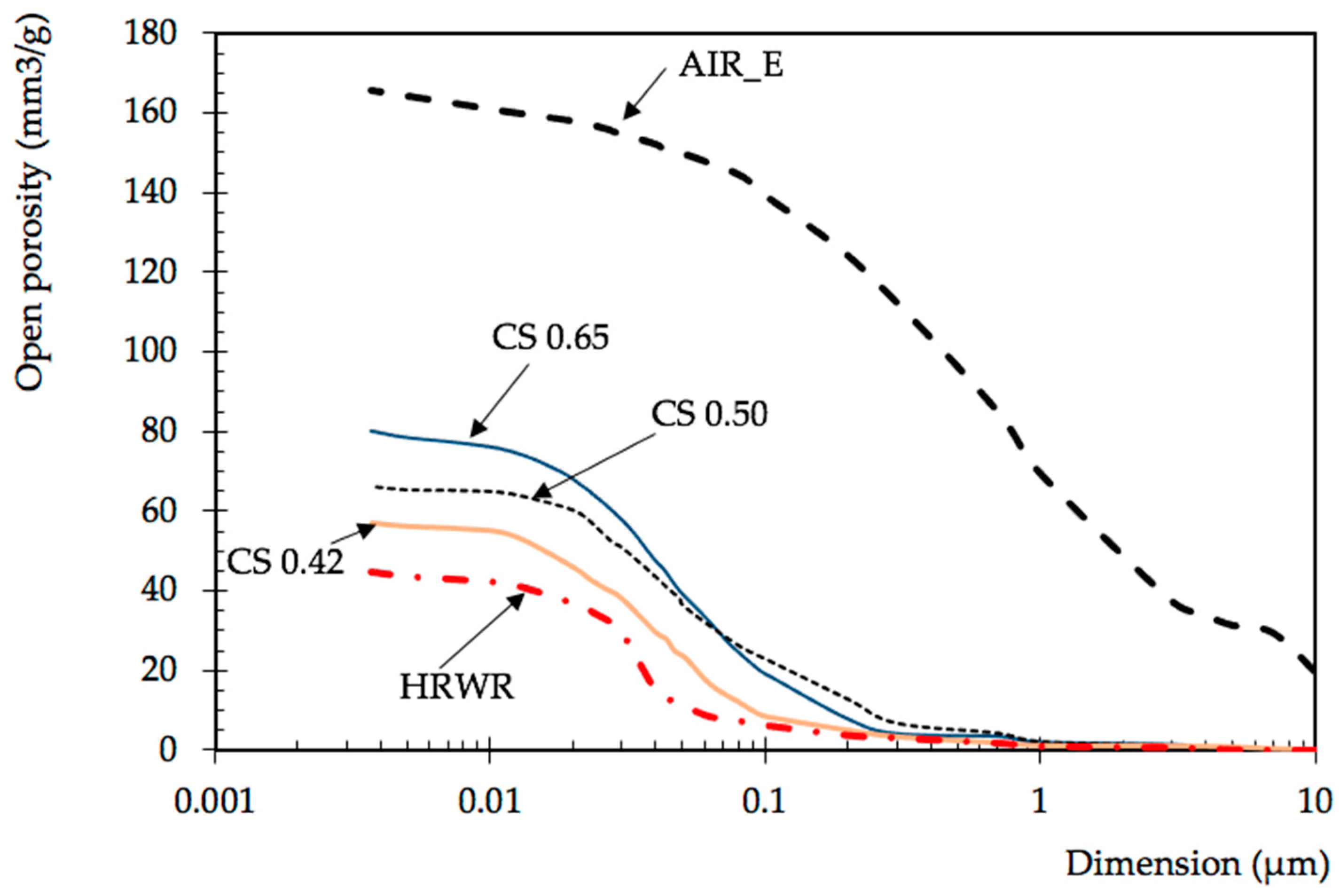
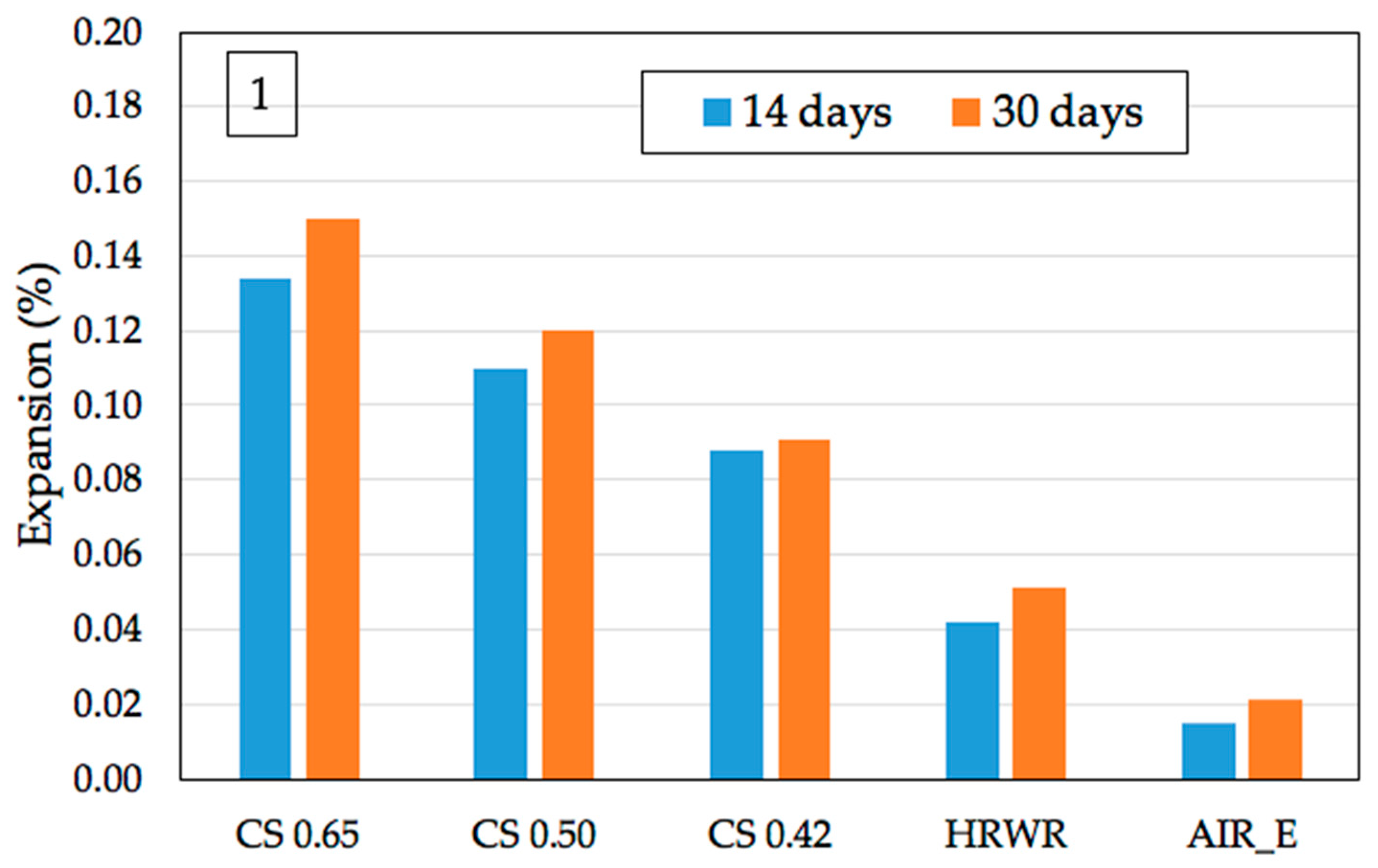
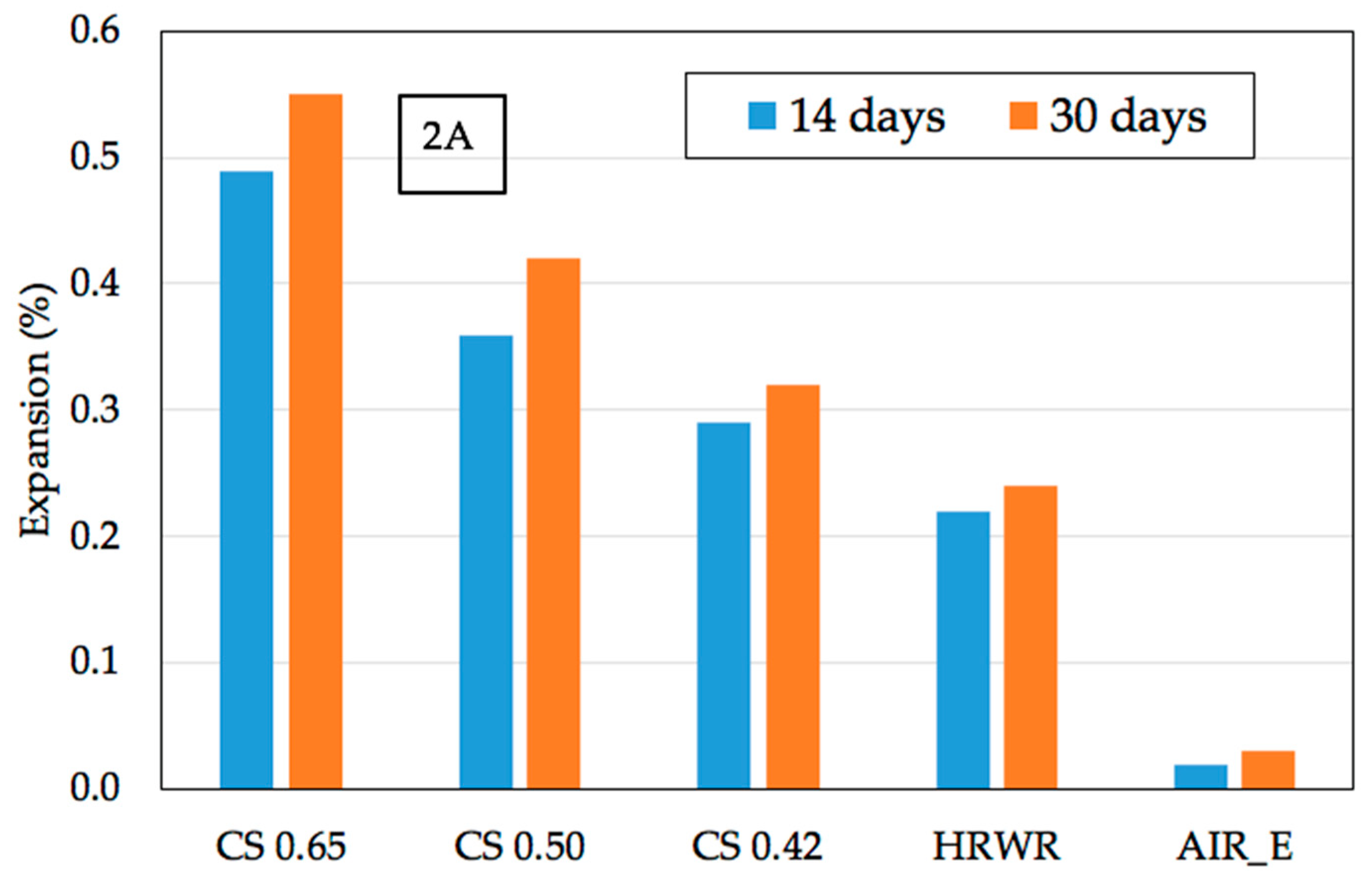
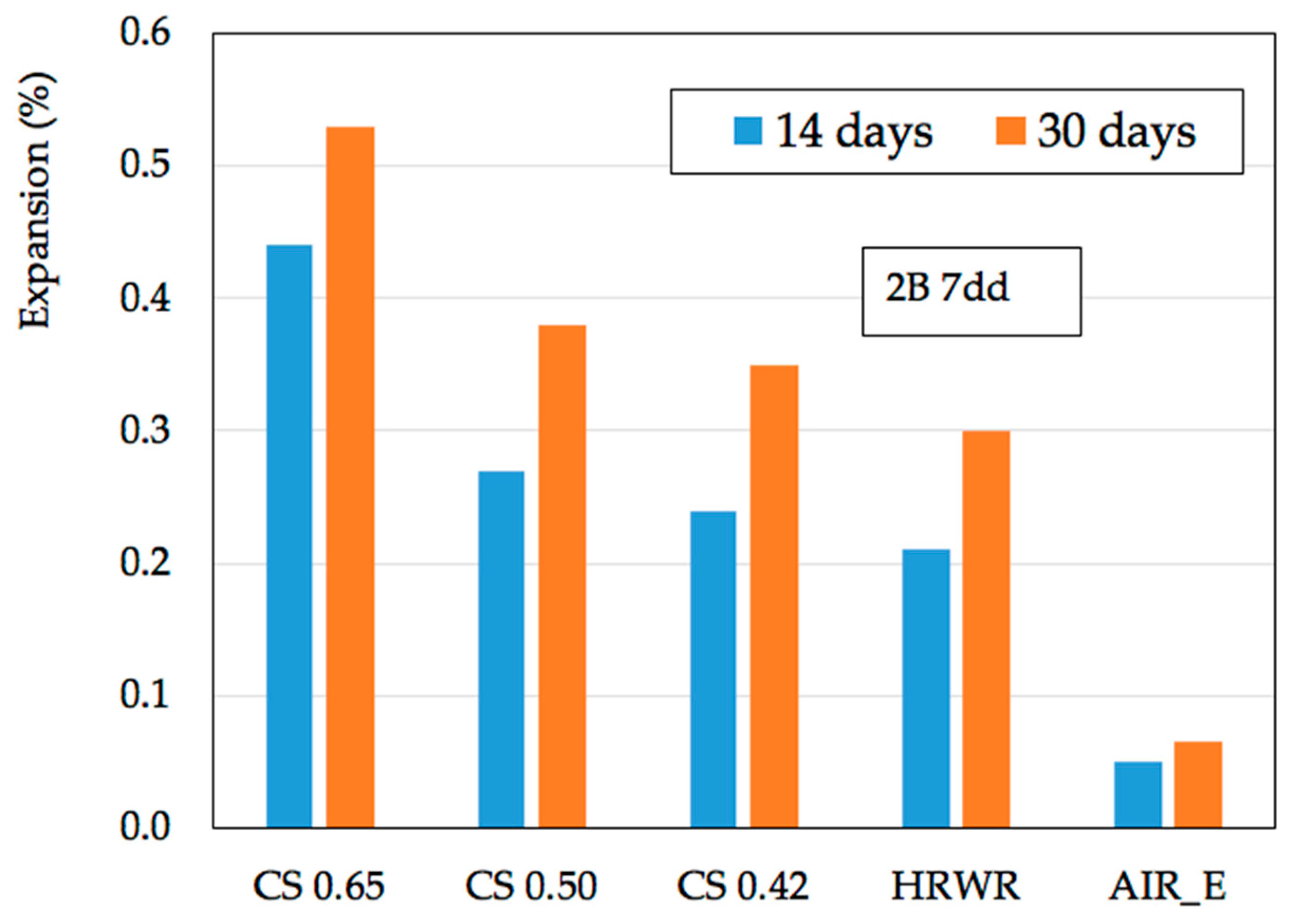


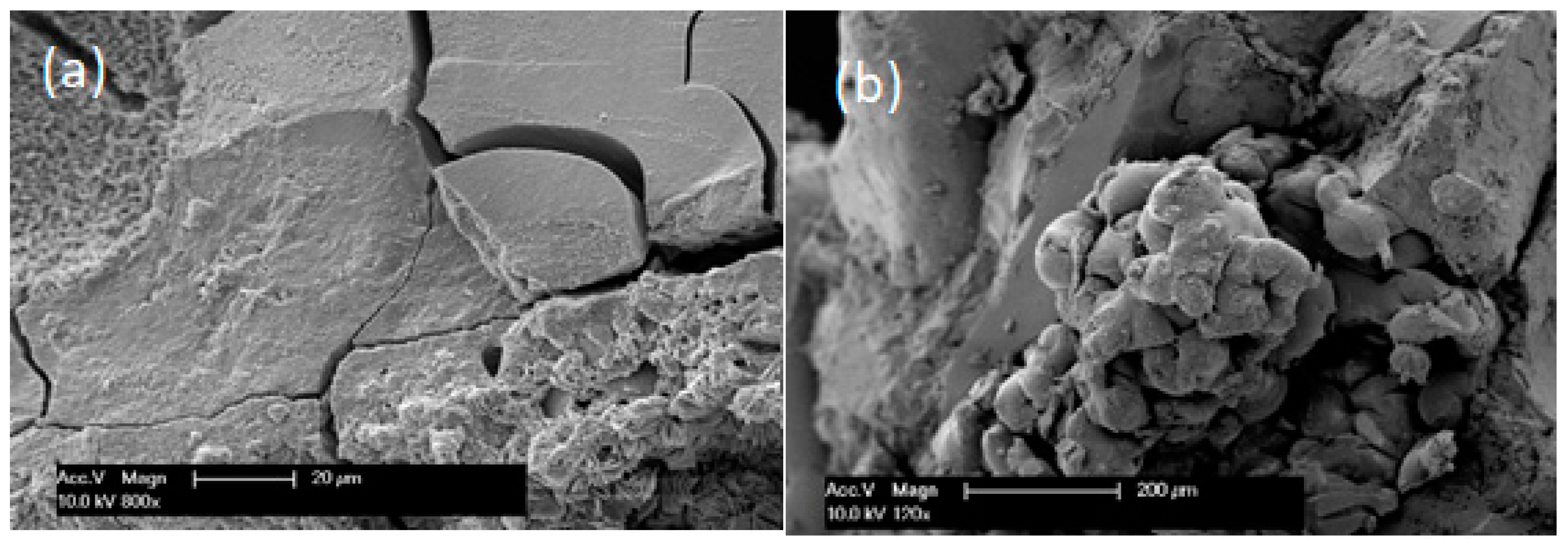
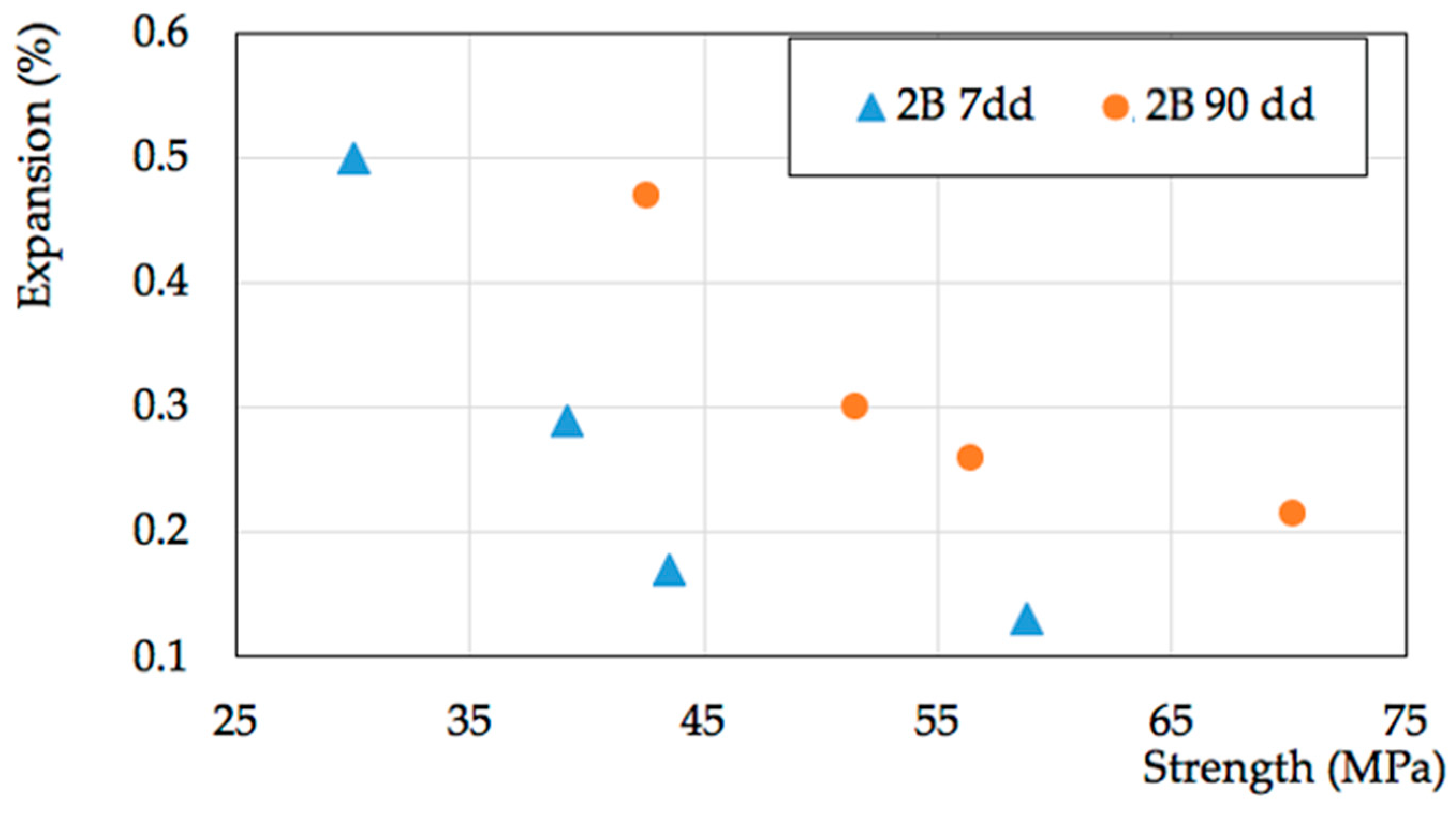

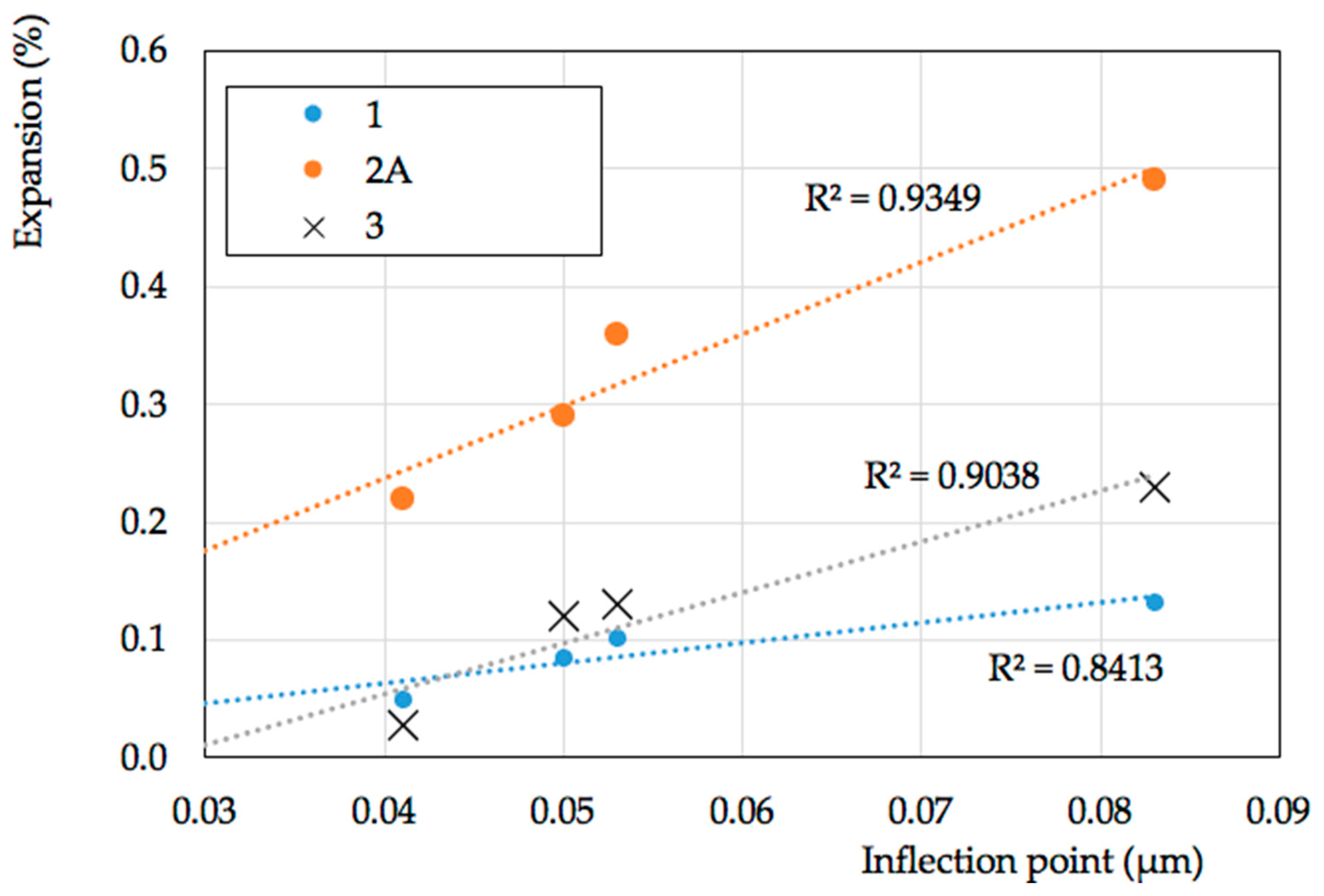
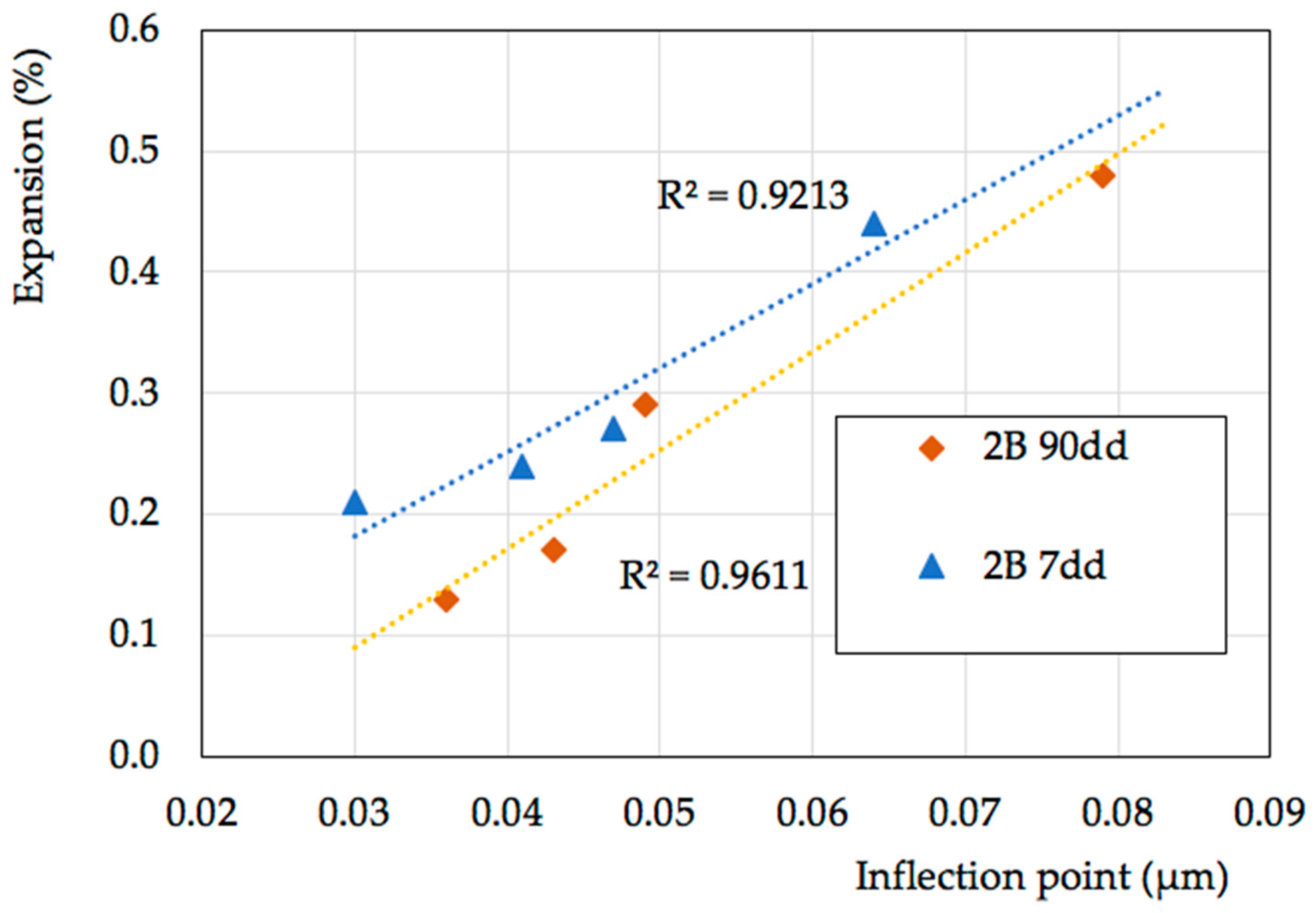
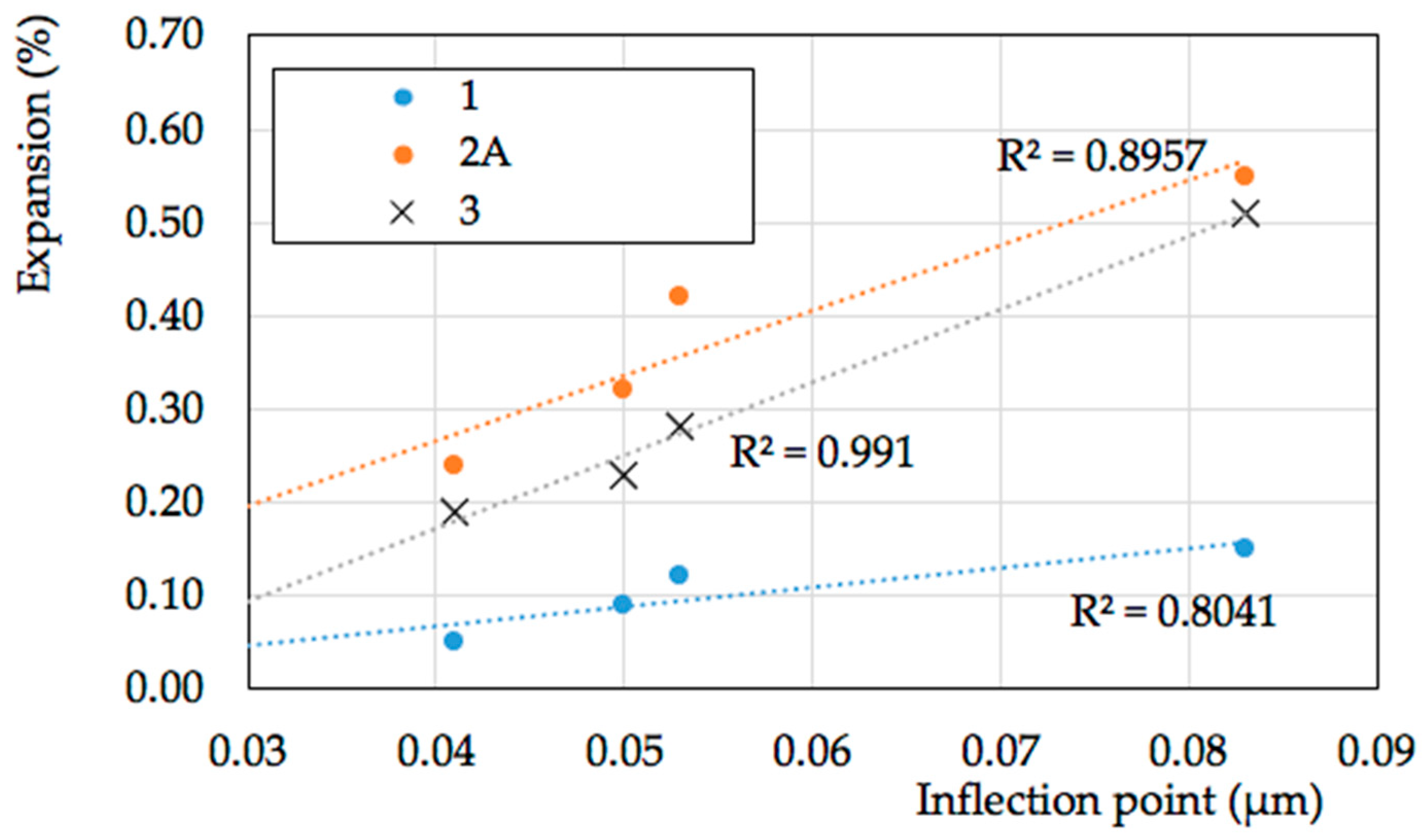
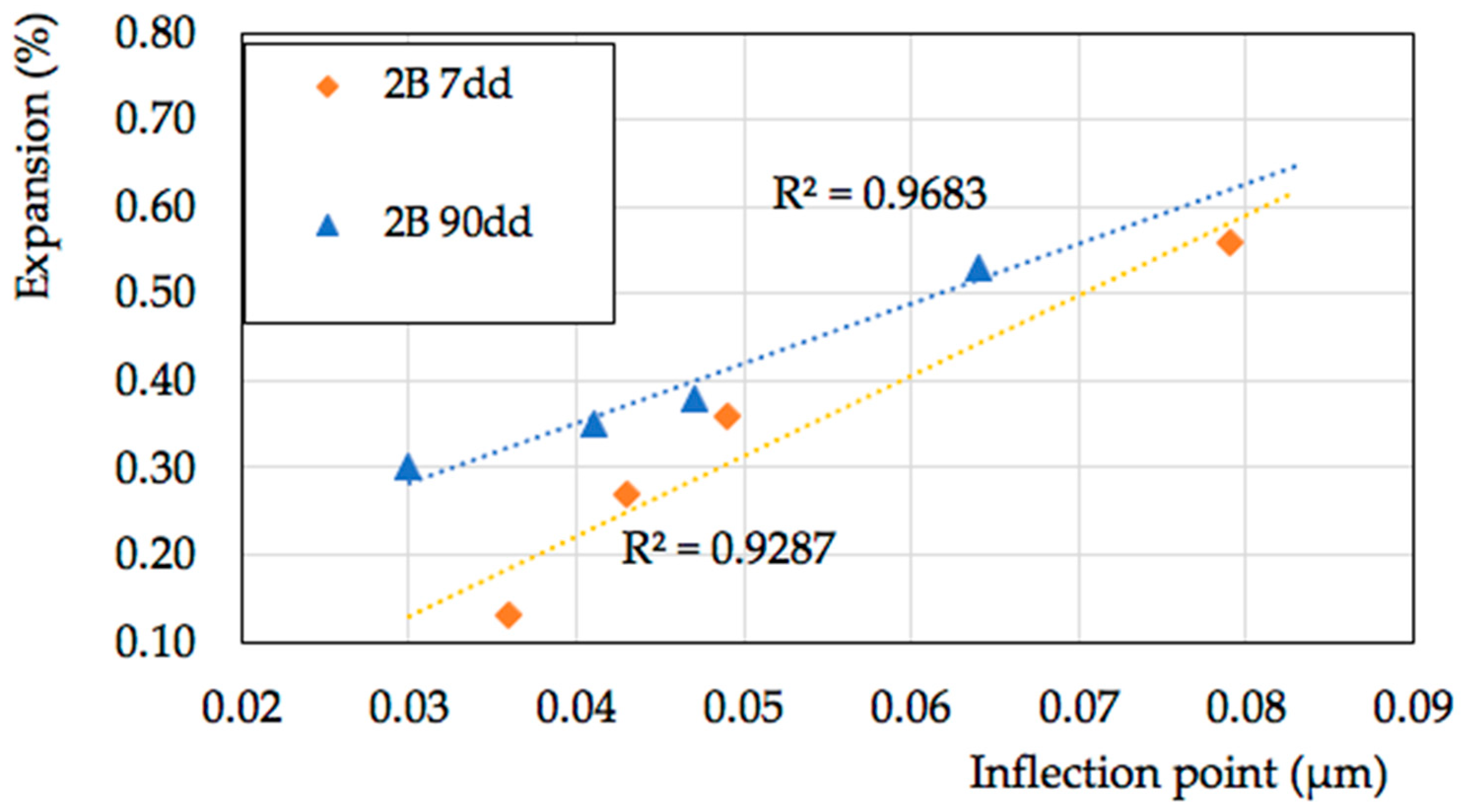
| Sample | w/c | Air-entraining Additive (wt%) 1 | High-Range Water-Reducing Additive (wt%) 1 |
|---|---|---|---|
| CS 0.65 | 0.65 | - | - |
| CS 0.50 | 0.50 | - | - |
| CS 0.42 | 0.42 | - | - |
| HRWR | 0.35 | - | 1.5 |
| AIR_E | 0.50 | 0.5 | - |
| Sample | 7 Days (2B) | 90 Days (2B) | 7 Days (1-2A-3) | |||
|---|---|---|---|---|---|---|
| E (GPa) | Rc (MPa) | E (GPa) | Rc (MPa) | E (GPa) | Rc (MPa) | |
| CS 0.65 | 37.2 | 30.0 | 38.6 | 42.6 | 36.9 | 28.6 |
| CS 0.50 | 38.5 | 39.1 | 40.5 | 51.5 | 37.1 | 37.3 |
| CS 0.42 | 38.1 | 43.5 | 40.4 | 56.4 | 36.9 | 41.1 |
| HRWR | 38.9 | 58.8 | 41.2 | 70.2 | 37.8 | 56.3 |
| AIR_E | 19.3 | 21.6 | 20.6 | 23.9 | 18.8 | 18.9 |
| Sample | Inflection Point (μm) | ||
|---|---|---|---|
| 1–2A–3 | 2B (7 Days) | 2B (90 Days) | |
| CS 0.65 | 0.083 | 0.079 | 0.064 |
| CS 0.50 | 0.053 | 0.049 | 0.047 |
| CS 0.42 | 0.050 | 0.043 | 0.041 |
| HRWR | 0.041 | 0.036 | 0.030 |
| Sample | 7 Days | 90 Days |
|---|---|---|
| CS 0.65 | 12.7 | 16.3 |
| CS 0.50 | 12.0 | 15.4 |
| CS 0.42 | 12.4 | 13.9 |
| HRWR | 10.9 | 13.2 |
| AIR_E | 11.8 | 15.4 |
Publisher’s Note: MDPI stays neutral with regard to jurisdictional claims in published maps and institutional affiliations. |
© 2022 by the authors. Licensee MDPI, Basel, Switzerland. This article is an open access article distributed under the terms and conditions of the Creative Commons Attribution (CC BY) license (https://creativecommons.org/licenses/by/4.0/).
Share and Cite
Saccani, A.; Manzi, S. The Role of Microstructure in Alkali–Silica Reaction Tests. Crystals 2022, 12, 646. https://doi.org/10.3390/cryst12050646
Saccani A, Manzi S. The Role of Microstructure in Alkali–Silica Reaction Tests. Crystals. 2022; 12(5):646. https://doi.org/10.3390/cryst12050646
Chicago/Turabian StyleSaccani, Andrea, and Stefania Manzi. 2022. "The Role of Microstructure in Alkali–Silica Reaction Tests" Crystals 12, no. 5: 646. https://doi.org/10.3390/cryst12050646
APA StyleSaccani, A., & Manzi, S. (2022). The Role of Microstructure in Alkali–Silica Reaction Tests. Crystals, 12(5), 646. https://doi.org/10.3390/cryst12050646






